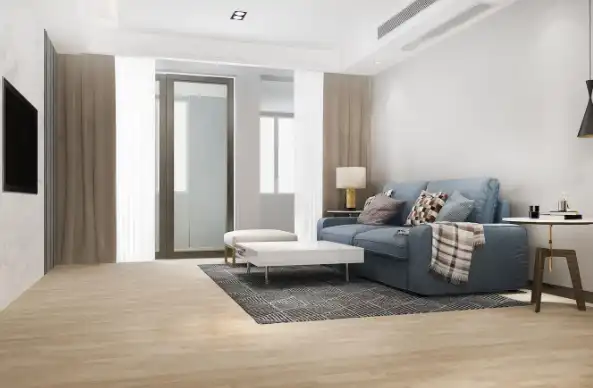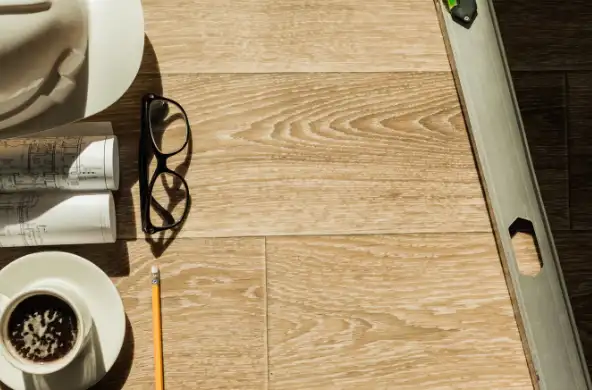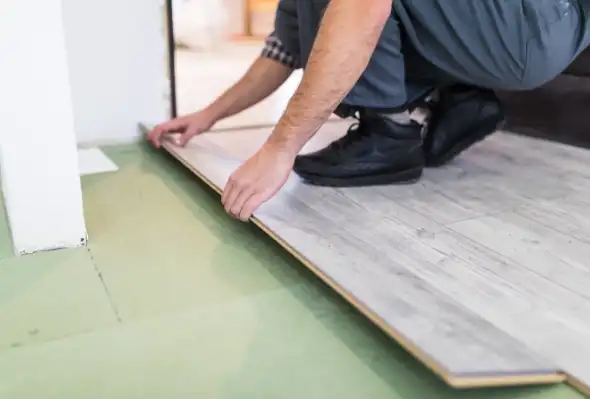
What Preparations Are Necessary Before Installing SPC Flooring?
Good preparation is key. It creates a perfect SPC floor installation. Before setting the first plank, installers must make sure the base floor is dry, flat, and clear of dirt. Testing for moisture, cleaning the surface, and getting tools ready are important steps. These stop future problems like warping or uneven seams.
Evaluating the Subfloor Conditions
A steady base floor is a must for SPC flooring to work well. Installers must check moisture amounts and flatness. Fix any issues before starting. Skipping this can cause early wear, noise, or floor failure.
Moisture Testing and Levelness Requirements
Before starting SPC flooring work, look at the base floor condition. Begin with the pre-installation phase. This includes checking moisture levels with a moisture meter. Too much moisture can harm SPC planks, even though they are waterproof. The base floor should also be flat within an allowed difference of 3/16 inch over 10 feet. Fix any low spots or high areas using self-leveling compounds or grinding tools.
Cleaning and Debris Removal
A clean base floor helps planks stick right. It also lowers the chance of harm during the job. Remove all dust, dirt, oil, and trash completely. Vacuuming and damp mopping are best to create a clean surface.
LanHe knows that base floor work is often missed. But bad leveling or leftover dirt can cause long-term problems in SPC flooring systems.
Gathering the Required Tools and Materials
Speed and exact work need the right tools. From utility knives to tapping blocks, having a full tool set lowers mistakes. It also protects planks during cutting and locking.
Essential Tools for SPC Installation
Get the right tools and supplies. Tools usually needed are a tape measure, utility knife, rubber mallet, tapping block, pull bar, spacers, square ruler, and saw (jigsaw or circular). These tools help make exact cuts and tight seams.
Recommended Safety Equipment
For safety during cutting and handling planks, installers should use gloves, safety goggles, knee pads, and hearing protection when using power tools.
LanHe notes that missing or poor tools slow down the job. They also raise the chance of harming planks or causing injury.
Acclimating the SPC Flooring Planks
SPC planks must get used to room conditions before putting them down. This stops growing or shrinking after the job. Skipping this step risks gaps, buckling, and costly fixes.
Importance of Temperature and Humidity Control
SPC flooring must sit in the room it will be put in for at least 48 hours before starting. The room heat should stay between 60°F–80°F (15°C–27°C). The air dampness should be between 35%–65%. This lets the planks adjust to room conditions. It lowers growing or shrinking after the job.
LanHe points out that skipping this step often causes buckling or gaps after the job. This happens because of changes in room heat or dampness.
How Should the Room Be Measured and Layout Planned?
A smart layout cuts waste and improves looks. Exact measures and direction planning make sure the flooring fits room size and light sources well.
Calculating Square Footage Accurately
Right measuring is basic for knowing how much material you need. Measure length × width for each part of the room. Then add 10% extra for waste from cuts and errors.
Planning the Direction of Plank Installation
Running planks parallel to the longest wall or light sources elongates the space visually. A thoughtful direction choice minimizes visible seams and enhances flow.
Visual Flow and Lighting Considerations
Planks should usually run the same way as the longest wall. Or line up with natural light sources like windows. This makes the floor look better by hiding seams and improving flow.
Marking Reference Lines for Proper Alignment
Use chalk lines to mark starting rows across the room’s center. These guides keep rows straight during the whole job.
LanHe stresses that bad layout planning causes too much waste or crooked rows. This hurts both how the floor works and how it looks.
What Are the Key Steps in Installing SPC Flooring?
From the first row to the last cuts, each step needs careful work. Good locking, offset seams, and fitting around objects make sure the floor lasts and looks finished.
Installing the First Row with Precision
The first row sets the pattern. Expansion gaps and straight lines stop building up mistakes. This makes sure later rows lock together well.
Ensuring Expansion Gaps Around Perimeter Walls
Leave an expansion gap of about 1/4 inch near all walls. Use spacers for this. This lets the floor grow naturally without causing buckling.
Securing Straight Alignment from the Start
A perfectly aligned first row sets the foundation for a flawless SPC flooring installation. Ensuring straight alignment from the outset prevents cumulative errors in subsequent rows, maintaining both structural integrity and visual harmony.
Quick & Easy Guide For SPC Flooring Installation.
Begin laying your first row along a straight chalk line. Use full-length boards when you can. A straight first row makes sure all next rows line up right.
Continuing with Subsequent Rows
Steady work is key. Angling planks correctly and using tapping blocks make sure seams are tight. Offset joints spread weight evenly.
Locking Mechanism Techniques for Tight Seams
SPC planks use a click-lock system. Tongues fit into grooves at an angle. Then press them flat. Gently use a tapping block and mallet to get tight seams without harming edges.
Staggering Joints for Structural Stability
Offset end joints by at least 6 inches between nearby rows. This spreads stress evenly over the whole floor surface.
Fitting Planks Around Obstacles and Irregular Areas
Pipes, doorways, and corners need careful cutting. Templates and jigsaws help fit planks without hurting strength.
Cutting Techniques for Pipes, Door Frames, and Corners
Use templates or measure well when cutting around pipes or door frames. A jigsaw gives exact cuts when shaping planks around odd shapes.
LanHe notes that bad cutting can leave clear gaps or weak plank edges near objects. This hurts both lasting quality and looks.
How Is Trimming, Finishing, and Cleanup Handled?

The last touches count. Good trim work and gap checks make a pro look and long life.
Installing Baseboards and Transition Strips
Moldings should match the flooring while letting it move. Fix them to walls—not the floor. This stops buckling.
Choosing Compatible Moldings
Pick moldings that match your SPC flooring’s color. They should also cover movement gaps under them.
Securing Without Restricting Floor Movement
Baseboards should be fixed to walls—not floors. This avoids stopping floating floor movement. That movement could cause buckling later.
Final Inspection and Surface Cleaning
A close check for gaps and dirt makes sure the job is perfect. Gentle cleaning keeps the floor’s finish safe. It won’t harm waterproof cores.
Checking for Gaps or Lifting Edges
Look at all seams closely. Re-tap any spots showing gaps or lifted edges before finishing trim work.
Removing Dust and Residual Adhesive (if any)
Most SPC jobs don’t need glue. But any glue left from transition strips should be cleaned off. Use cleaners the maker says are okay.
LanHe sees that finishing touches like trims are often rushed. Yet these parts play a big role in making sure the SPC floor stays stable over time.
Why Is Post-Installation Care Important?
Protecting your work starts right away. Letting floors settle and using right cleaning ways makes them last longer and look better.
Allowing Proper Settlement Time Before Use
Don’t put heavy furniture on a new floor for at least 24 hours. This lets planks settle evenly under room conditions.
Recommended Maintenance Practices for Longevity
Daily sweeping and avoiding too much water stop wear. Felt pads and careful furniture moving guard against scratches and dents.
Daily Cleaning Routines
Sweep daily with soft brooms. Avoid wet mops. Too much water might get into joints over time, even with waterproof cores.
Avoiding Damage from Furniture or Heavy Loads
Use felt pads under furniture legs. Don’t drag heavy things straight across the floor. This could scratch the top layer over time.
LanHe suggests clear after-install rules be followed closely. Many issues come not from poor work but from using the floor too soon or bad care habits later.
What Are Common Challenges During SPC Installation?
Even trained installers face problems like uneven base floors or lock failures. Active problem-solving makes the job smooth.
Dealing with Uneven Subfloors or High Moisture Levels
Uneven bases need leveling compounds. High moisture spots need vapor barriers, even with waterproof SPC goods.
Managing Expansion Gaps in Large Spaces
For rooms bigger than 40 feet long or wide, you might need extra expansion joints. Follow the maker’s rules. This stops stress build-up.
Addressing Locking Mechanism Failures or Damaged Planks
Broken lock tabs must be swapped out right away. Forcing bad planks into place risks seam strength for whole sections.
LanHe sees these common issues as key trouble spots for DIY installers. It shows how knowing the job plus good materials means fewer problems during the work.
Who Is Shandong Lanhe Import and Export Co., Ltd.?

A trusted world supplier, LanHe mixes good SPC flooring with expert help. Their ISO-certified goods meet tough rules for lasting quality and safety.
Overview of Shandong Lanhe as a Trusted Supplier
Shandong Lanhe Import & Export Co., Ltd., based in China’s Shandong area, makes high-quality SPC flooring solutions for world markets.
Quality Standards in Manufacturing SPC Flooring
The company follows ISO9001 quality rules in all its making lines. This keeps thickness, wear layer stick strength, UV coat lasting quality, anti-slip ratings, and no-formaldehyde promises the same on all goods sold worldwide.
Global Distribution Capabilities and Support Services
With strong shipping links across North America, Europe, Southeast Asia—and many-language help—LanHe sends not just materials. They also give technical help through your whole job, from planning to after-install care.
Conclusion
Putting in SPC flooring needs very careful prep—from checking base floors to doing exact layouts. All guided by knowing how the material acts under room conditions. A good job mixes technical skills with reliable goods like those from Shandong Lanhe Import & Export Co., Ltd. This makes sure you are happy long-term with how the floor works and looks through every step by step guide part of your flooring task.
FAQs About SPC Flooring Installation
What is the ideal temperature range for installing SPC flooring?
The best range is between 60°F–80°F (15°C–27°C) with air dampness between 35%–65%.
Can SPC flooring be installed over existing tile or vinyl?
Yes—if the old surface is flat, clean, dry, steady—and free from cracks or loose tiles/vinyl sheets.
How long should I wait before placing furniture on newly installed SPC flooring?
Wait at least 24 hours after finishing before putting heavy furniture down. This lets planks settle right under room conditions.


